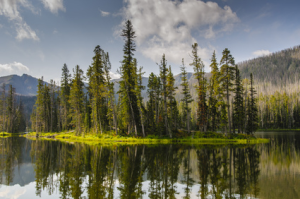


Presentation title:
Where are the forests in the United States “not disturbed” over a quarter century?
What are the major findings of your research?
- About 1.7 million square kilometers, or two thirds of 2.6 million square kilometers of forest in the conterminous U.S. did not experience any detectable natural or anthropogenic disturbance during the quarter century between 1986 and 2010 (see figure 1)
- The northern states in the eastern U.S. have the highest percentage of forest remaining undisturbed, while those in the south have the lowest values
- At any given time interval, the percentage of forest remaining undisturbed decreases following an exponential decay function as the time interval increases (see figure 2)
- If forest disturbance rates remain relatively stable over time, the conterminous U.S. would have less than 20% forest remaining undisturbed in 100 years, which would become less than 4% in 200 years
- Management approaches aimed at reducing timber harvest rates in the south and mitigating fire risks in the west are needed in order to maintain higher levels of undisturbed forests.
What insight did you gain from Landsat that would have been impossible to glean otherwise?
- Without Landsat, we wouldn’t be able to quantify the amount of forest undisturbed over multiple decades at local, regional, state, and national scales;
- We wouldn’t be able to reveal that the percentage of forest remaining undisturbed at any given time interval decreases following an exponential decay function as the time interval increases, and therefore wouldn’t be able to estimate how much forest would remain undisturbed over multiple centuries.
What are the major implications of your findings?
- Old growth forests (> 100-200 years): mostly in the north and west, very little in the south, may constrain the distribution of species that favor old growth forests;
- Forest carbon stock: because old growth forests typically have higher carbon density than young forests, the south have more potential to increase its forest carbon stock than other forested regions in conterminous U.S.;
- Management approaches aimed at reducing timber harvest rates in the south and mitigating fire risks in the west are needed in order to increase and maintain higher levels of undisturbed forests.
Co-authors:
Feng Zhao
University of Maryland College Park
Samuel Goward
University of Maryland
Karen Schleeweis
Organization Not Listed
Andrew Michaelis
California State University Monterey Bay
Jeffrey Masek
NASA Goddard Space Flight Center
Jennifer Dungan
NASA Ames Research Center
Warren Cohen
US Forest Service Corvallis
Gretchen Moisen
US Forest Service Fort Collins
Khaldoun Rishmawi
University of Maryland College Park
Anyone can freely download Landsat data from the USGS EarthExplorer or LandsatLook.
Further Reading:
+ Chengquan Huang’s UMD profile
+ A Quarter Century US Forest Disturbance History from Landsat – the NAFD-NEX Products, NASA Science Visualization Studio
+ Landsat at #AGU15






